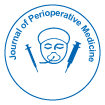
Journal of Perioperative Medicine
Open Access
ISSN: 2684-1290

ISSN: 2684-1290
Perspective - (2024)Volume 7, Issue 6
Pediatric anesthesiology is a specialized branch of medicine focused on administering anesthesia to infants, children and adolescents. This field is essential for ensuring that young patients receive safe, effective care during surgeries and medical procedures. Pediatric anesthesiologists play a significant role in addressing the unique physiological and psychological needs of children to minimize risks and ensure comfort.
Preoperative assessment and preparation
Effective pediatric anesthesiology begins with a thorough preoperative assessment. This step is essential for understanding a child’s medical history, any potential allergies and prior reactions to anesthesia. Pediatric anesthesiologists collaborate with other specialists, such as pediatricians and surgeons, to gather comprehensive information and create a modified anesthesia plan.
Psychological preparation is also a critical aspect of preoperative care. The fear and anxiety associated with medical procedures can be intense for children and may lead to non-cooperation, making the administration of anesthesia more difficult. Pediatric anesthesiologists use child-friendly language and engage with children in a way that helps build trust and reduce anxiety. Techniques like play therapies, interactive storytelling and, videos can be used to provide comfort and understanding, enhancing the overall experience for young patients.
Types of anesthesia used in pediatric patients
Different types of anesthesia are chosen based on the nature of the surgery or procedure, the age and health condition of the child and the expected duration of the procedure. The main types of anesthesia used in pediatric care include:
General Anesthesia (GA): This is the most common type used in pediatric surgeries. It induces a state of unconsciousness and blocks pain throughout the body. Children under GA require close monitoring, as they are more susceptible to airway complications and changes in blood pressure.
Regional anesthesia: This method numbs a specific part of the body, such as during surgeries involving the lower extremities or abdomen. Epidural or spinal anesthesia might be used, particularly in older children. The advantages of regional anesthesia include reduced need for general anesthetics, faster recovery and lower risk of systemic side effects.
Sedation: For less invasive procedures, sedation can be used to help a child stay calm and pain-free without complete unconsciousness. Sedation levels vary from minimal (relaxed but awake) to deep (sleepy but can be awakened easily).
Advances and safety protocols
Recent advances in pediatric anesthesiology focus on improving safety and efficacy. These include the development of new drugs that are shorter-acting and associated with fewer side effects. The incorporation of advanced monitoring technologies, such as capnography and brain wave monitoring, helps anesthesiologists track vital signs and adjust anesthesia in real-time.
The Pediatric Anesthesia Neuro Development Assessment (PANDA) initiative and other research efforts investigate the long-term effects of anesthesia on children's neurodevelopment. These studies aim to balance the necessity of anesthesia with any potential risks, ensuring that children receive the safest possible care.
Recovery and postoperative care
Postoperative care in pediatric anesthesiology requires careful observation and management. Children can react differently during recovery, with some experiencing confusion, agitation or nausea. Pediatric anesthesiologists and nurses are trained to recognize and address these issues promptly. The goal is to provide a smooth transition from the operating room to recovery, ensuring pain management and preventing complications.
Parents play an important role in the recovery process, providing reassurance and familiarity. Clear communication with parents about what to expect post-surgery and how to manage pain at home is important for the child’s comfort and recovery.
Pediatric anesthesiology is a complex, specialized field that requires extensive knowledge, skill and empathy. The combination of modified anesthetic techniques, thorough preoperative and postoperative care and continuous research contribute to improved outcomes for young patients. The field’s commitment to safety and child-centered approaches ensures that children receive the best possible care during their medical journeys.
Citation: Fu M (2024). Pediatric Anesthesiology: Ensuring Safe and Effective Care for Children. J Perioper Med. 07:255.
Received: 23-Oct-2024, Manuscript No. JPME-24-35274; Editor assigned: 25-Oct-2024, Pre QC No. JPME-24-35274 (PQ); Reviewed: 08-Nov-2024, QC No. JPME-24-35274; Revised: 15-Nov-2024, Manuscript No. JPME-24-35274 (R); Published: 22-Nov-2024 , DOI: 10.35841/2684-1290.24.07.255
Copyright: © 2024 Fu M. This is an open-access article distributed under the terms of the Creative Commons Attribution License, which permits unrestricted use, distribution, and reproduction in any medium, provided the original author and source are credited.